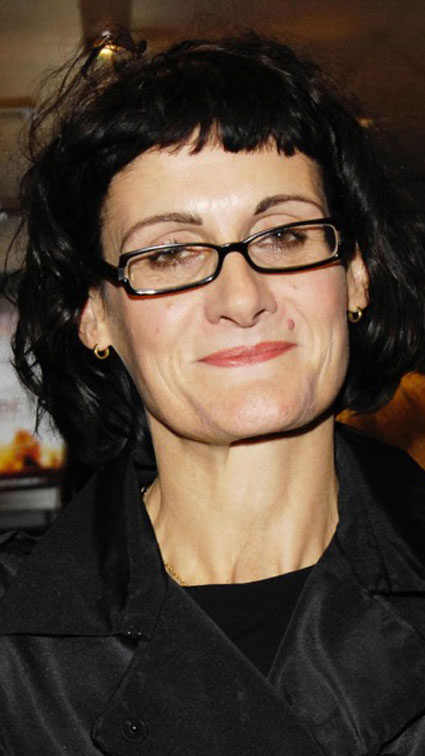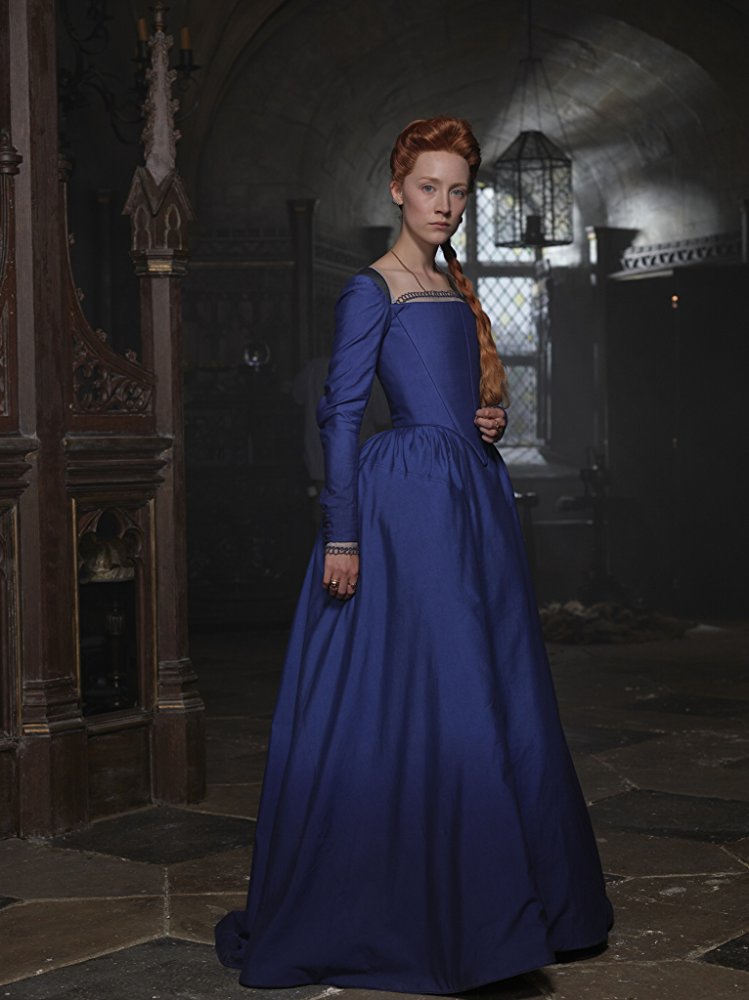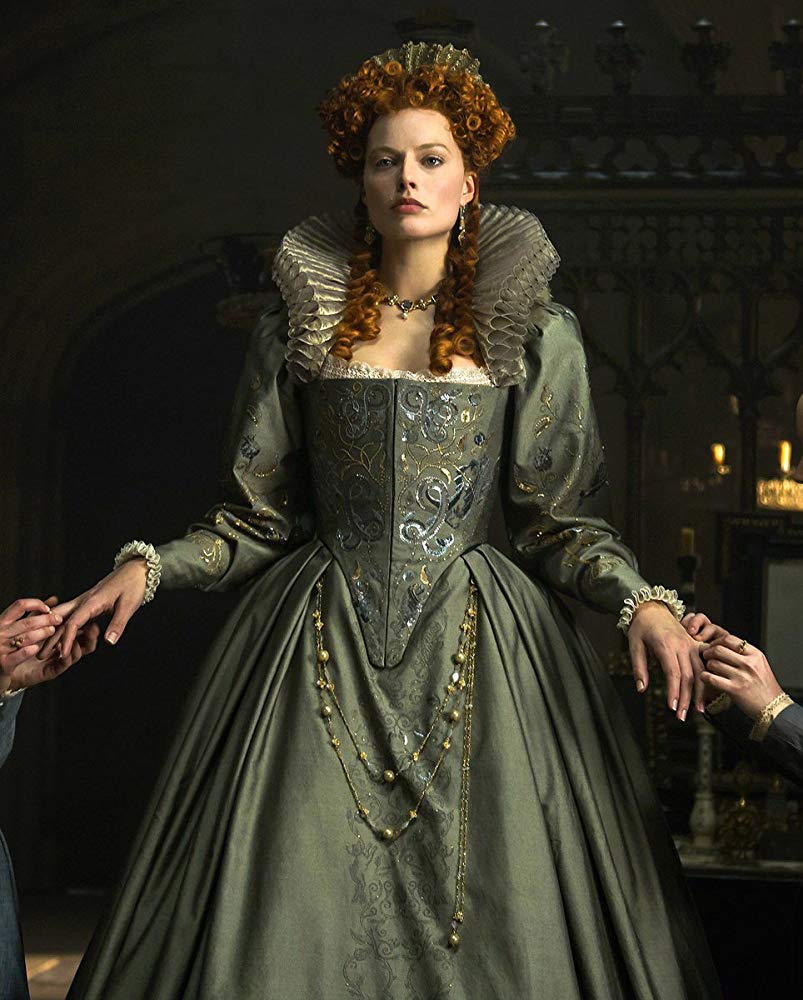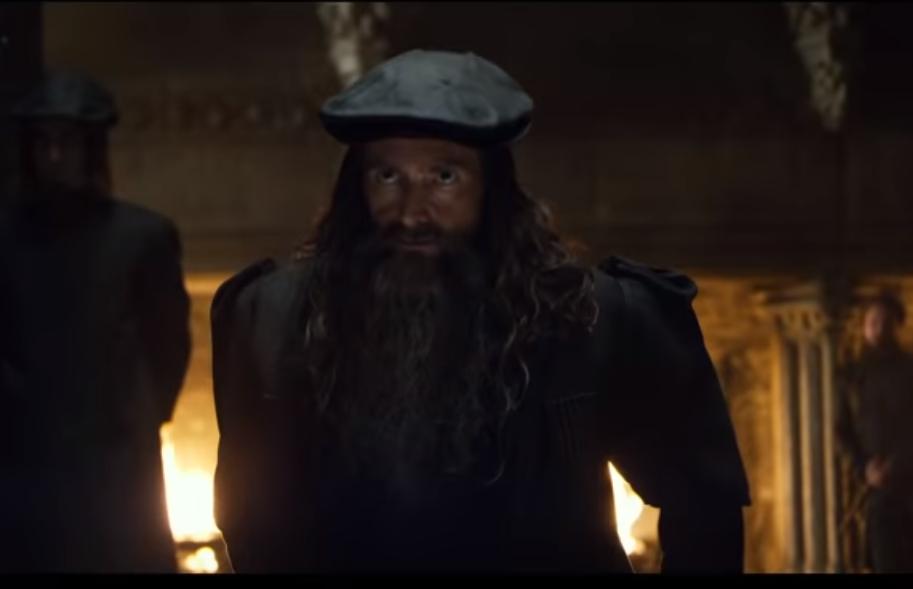Don’t be surprised to hear the name of costume designer ALEXANDRA BYRNE announced come Oscar nominations morning. Previously Oscar-nominated for her work on “Elizabeth” and the Oscar winner for “Elizabeth: The Golden Age”, Byrne revisits the Elizabethan era for the third time with MARY QUEEN OF SCOTS, starring Saoirse Ronan as Mary I of Scotland and Margot Robbie as Elizabeth I. But this go-round, as with Beau Willimon’s script giving us a new perspective on the relationship between Elizabeth and Mary, Byrne takes a completely different approach to costume design, opting to meld the denims of today’s everyday lifestyle with the fashion and style of 16th century England and Scotland for a modernized yet period-perfect look.

With a threatre background herself, working with first-time feature director Josie Rourke who comes to the film fresh from years as an acclaimed artistic theatre director in London, Byrne found the collaboration not only rewarding, but with their shared theatre experience, aided in understanding the actors and how they work, not to mention a shared sense of storytelling, a big part of which encompassed Rourke’s philosophy of “go big or go home”, something Byrne wholeheartedly embraced, leading her to her own vision of denim design and fabric manipulation.
Byrne outdoes herself with the originality of the concept. Unconventional and innovative, the resulting costumes are rich, textured and beautiful, boasting nuanced modern touches without detracting from the period. The gowns on both Ronan and Robbie are all made of denim of various weights, and thanks to the various gauges of the fabric, dying of the fabric, and the distressing and aging processes, often give the appearance of gorgeous moire silks or brocades. Intricate and ornate embroidery is also a defining part of the look. Byrne creates a beautiful contrast between the cleaner lines and bold colors of blues, teals and bronze on Ronan’s Mary versus the overly big-skirted, flamboyant and ornate nature of the texture and design of those costumes for Robbie’s Elizabeth. Interesting are little touches such as turned up cuffs on sleeves and skinny jean leggings that modernize the looks while still retaining the feel of the period. Appreciative is that Byrne allowed the weather to affect the fabrics in a natural fashion, allowing mud and muck to stay on the garments to enforce the fact that people of the era lived in their clothes and would wear them for days on end. Look closely and in some instances as mud dries on one of Mary’s gowns, it reveals an imprint within the fabric of the Scottish coat of arms. Jewelry is period perfect and each piece handmade based on portraits of the day. Similarly for the men, stretch denim became a favorite of Payne’s for designing leggings given that men’s fashion of the day focused on “the crotch and thighs.”
Engaging, affable and candid, ALEXANDRA BYRNE was nothing short of a delight during this exclusive conversation talking about her vision and process of the costume design for MARY QUEEN OF SCOTS. . . .

Alexandra, you have done a masterful job with the costumes in this film. I am in love with them and love them even more, knowing that they are denim. And I must say, the jewelry? Be it Mary’s jewelry or Elizabeth’s jewelry, all of it is absolutely perfect for each of the characters, not just the period, but the character of each of these women. Your work in MARY QUEEN OF SCOTS is simply exquisite.
Thank you. It was a great job, I have to say. It was one of those jobs that you just think, “We’re going to be ambitious, we’re going to go for it!”. But, I love it!

What I really love is that you come off of the two prior “Elizabeth” movies and yet, you create entirely new looks for this movie and particularly when it comes to Mary; your clean lines, the simplicity of the clothes and I have to say, the bodice on almost every dress she has where it’s a set-in piece, it looks like a piece of armor. Stunning. I love it.
Thank you, thank you. I think it’s interesting. I think having done the two “Elizabeth” films beforehand give me a safe line of knowledge of the period that actually enables me to make the big set, to revisit the material in a completely different way because when you’re designing a period film, as a designer I like to know the period inside out so that I’m very much in control of the decisions I’m making. So, if you’re starting a period film afresh, it feels like you’re the wrong way trying to get your head and your understanding into the period. But, because I had this big nut of knowledge, I think it meant that when I read the script I was able to go, “I know how I want to do it” and that was exciting.
When I look at the two women, side by side, your designs for Elizabeth speak power; a lot of white and gold, the opulence, the bigger flounce and bouffants. Very ornate. Then I look at Mary. Very practical. And you use the shades of blue that go from lighter blue into these beautiful, rich teals that look almost like a moire silk fabric with the texture.
They’re all denim. I have to tell you they’re all made of denim.

That is what amazes me the most about Mary’s clothes, about the men’s clothes and even, I think, on Elizabeth, you have denim.
Elizabeth’s are all denim. I used for her three main portraitures that we use. I very much wanted to do that because I felt for them to stylize the period I wanted it to be grounded and to have to locate into the history that we recognize and that is through portraiture. So you have this passage of time from Mary returning to England, and meeting Elizabeth to her execution which is 25 years, so I use those three portrait looks as she walked around the corridor to go through her changing phases and the time passage of 25 years. Other than that they are all denim.
I saw this on the big screen and I’m looking at particularly Mary’s clothes and these dresses and as I said, particularly when you get into the teal and richer color and the bronzes on her, the texture looks like a moire silk.
There you go. I think it’s about one of the things I knew I wanted to do in this film was to exert such an extraordinary story of these two women, and that story is so different, but what I didn’t want is this kind of revolving door of here comes another queen and another frock. I wanted to try to limit the materials I was using so that I was manipulating a fabric to tell that story. And that was the challenge, that was what I wanted to do, yeah.

What gauge of denims were you using to get the manipulation of fabric that you had?
Well, (laughing), there are many many kinds of denims. For the men in their tight trousers, we used stretch denim on the inner thigh. We used all kinds. Some of Elizabeth’s denims are a silk cotton denim, which meant you could get a kind of very lustrous color. You can go from a shirting weight denim right up to a sixteen ounce. Our fabric stockroom was not the best lit room, and you would constantly be going out, “Oh god, which denim is it!”. By the end you could almost see in the dark and know exactly which one you were going for. But some of them were over-dyed and then all the garments went through a big kind of aging distressing process because they didn’t have drycleaners. They lived in their clothes. Scotland is cold, wet, muddy, sunshine. They go through for everything. So for Mary’s court I wanted the dirt and the pattern to be part of the decoration. When she’s standing on the cliffs looking at England I think you can see it clear as day, there’s a huge kind of mud splashes up her skirt. And within that we’ve used kind of a reverse print to reveal the Scottish coat of arms within the mud. So I was playing games with that basically.
I just think the fabrication is gorgeous, and then the colors and the dying you’ve done to achieve the colors, stunning.
I have to say, I work in London and without my team I’m just a frantic jumble of ideas. I have a really really talented team, some of them I’ve worked with for 25 years, some of whom are new. But I think everybody on my team was very excited by this project. We had very little time and very little money, so it was a big kind of “let’s get to this” and my team really responded. They’ve made it work.

Alex, you’re working with Jenny Shircore again, so I’m curious how her wigs and makeup impacted the designs that you came up with, particularly for the two queens. As we see, we have moments where Mary’s hair is flowing and down and it’s beautifully backlit in the bedroom after the murder scene of Rizzio and her nightdress is like a very light gauzy, kind of linen almost. It looks so beautiful. But then other places we have a big up-do or beehive or something. I’m curious if knowing how the hair is going to look impacts what you are doing in designing the garment, the cut, the color.
Because those queens have a big story arc within the film and because Jenny and I have worked together before, we really get on. We have a very clear way of communicating which means we don’t pussyfoot around each other. We kind of bounce ideas off. I can say to her “No, that doesn’t work” and she can say “What are you doing there?” We have a very direct way of communicating. Huge affection and respect, and admiration for each other’s work. So that’s a very creative collaboration. Obviously, I start before Jenny does so I’m a certain way down the line in terms of what we’re doing. But then Jenny will be fitting photographs we’ve discussed and I think within the two queens story arc what we tried to do is not have every bit of visual information adding up to the same point because there are contradicts and juxtapositions and relationships that are more layered than that. So by working with Jenny we can build in those layers.
The two of you working together is like this seamless match made in heaven when it comes to film.
We work hard. It’s a very, it’s a very rewarding and special collaboration, yeah.

What kind of research did you do because you were already so familiar with the period but you wanted approach it with fresh eyes?
The interesting thing is when I last researched the period it was pre-internet. I did look back at my research and to remember when I looked it was so hard to find those images, whereas now we’re flooded with images. It’s a very different way of researching, but it’s still the same process for me because obviously initial meetings are all words describing visuals. So the next step for me is to just harvest images and then just to begin to build and edit these down to mood board. And in doing that edit and composition of the mood board I begin to clarify my ideas in a very instinctive way and by sharing those mood boards to Jenny, to the actresses, directors, production designer, everybody will see something different and it becomes a very inspiring conversation; whereas to draw costumes sometimes everybody then stops taking any responsibility because that’s the information that’s what it’s going to be and I like things to be much more collaborative and organic. And the interesting thing is I think it would have been impossible to draw with the denim because what I discovered is that every costume was about a balance between the modern association we have with denim and the authentic period costume. So for example, the first costume wasn’t even a costume, it was a fitting trial that we made for Saoirse. Normally you’d do that in calico but we did it in denim to get my head into what we were doing. And everything was correct to the shape and the proportion and the balance and the underpinnings and the corset and everything that I wanted to say Elizabethan. But we put a modern shirt cuff on the end of an Elizabethan sleeve. That was a kind of breakthrough moment where I began to understand that the game I was playing by using denim with Elizabethan. And I don’t think you can draw that because it was literally a balance of “do we use orange topstitching and rivets, or do we do something more contemporary”. It was balancing the look and the intonation in each costume.
And how far you could take it without making so blatantly modern that it looked out of place.
Yes. Exactly. And interestingly, the thing that was most difficult for me was the jewelry because you couldn’t – on the portraiture, yes, we recreated the Elizabethan jewelry – but with the denim I had to find a completely different language for the jewelry. I kept putting that off because I felt I needed to have costumes at a certain level to begin to understand the textures but that was hard actually.

I’m going to talk about the men’s costuming for a minute, particularly in the Scottish court, because there is some stand-out stuff happening in there with men’s attire, but the one outfit that stands out above all others and is so iconic is John Knox in the black.
Yes, yes! Well again, it was interesting in that by the time I met with David Tennant we were already filming so he was quite far down the schedule. So by then we already had quite a good understanding of the denim and how to use it. I think really after a while you’re working, you have to get through a lot of work in a day so you start to work very instinctively which is supported by the research and the background knowledge that you have, and by the time we came to Knox we relating to the portraits and the engravings we had of Knox and it was just a very instinctive combination of denim and portraiture that just came together I think.
It so striking and the minute he appears on screen we know exactly who that is. And he’s such a key figure in the story of the two queens. I was so happy to see that. But you change everything up amongst the male members of the courts. You’re not duplicating outfits. You have all of these extras that you’re also dressing. So, I’m curious how you developed the multiplicity of looks for the men within the courts, because so many of them are lords and you figure they’re gonna dress the same or very similarly. So what was that process like in designing the men?
So the principles, it was character by character. Each actor as they come into the fitting room and I start discussing with them, they have a big input in their ideas and their thoughts. And there’s physicality as well. It’s not one size fits all. How people stand, how they move, their physique, proportions that work on them, so you are very much dressing each body. For the Elizabethan men, the sexuality was all in the legs and the crotch, so I wanted to keep that emphasis. And that was the kind of the way into their sexuality, but also just feeling the biker boys of denim so there was all that language going on. Different actors responded to it in different ways and took it on in different ways, so it was a very collaborative process to develop the clothes. But the thing that was clear about the men was that they came to their fitting with kind of drooped shoulders, thinking “Oh, here we go type [thinking] pumpkin britches”. But then explaining the concept to them and starting the fitting, the physique changed and the shoulders broadened and there was kind of a strutting quality in the fitting room which was very pleasing.

That’s something that I mentioned to Josie [Rourke] when I talked to her the other week. I have never seen a film, where people have such fabulous posture. And I know that so much of that comes from the garment, especially when wearing denim which for the most part really will make you stand a different way.
Yeah. I also think it was the hip belts that the men had, this kind of swagger that fit like a gunslinger’s belt. I think it’s immensely enabling. They felt good in it. It just looked good.
For you, Alexandra, being a costume designer and working with fabrics all the time, what was the most surprising thing to you about the denim in terms of how you could manipulate it?
The very first thing we did, having thought that denim was the answer, was make a man’s Elizabethan doublet completely accurately out of denim. It was really horrible, self-conscious, bad costume. And that had me with a kind of “I think I’m going home early, I need to think about this”. [But] actually there was a moment where I realized that what I was doing, I still had faith in but I was seeing what it’s true potential was, which was finding a way of combining the preconceptions we have about denim, because it’s so much a part of our lives, with the Elizabethan. So that was the most exciting part – is actually understanding of what I was taking on; that was moment by moment. Also, I think that the kind of smallage of it is trying to step back and say “Am I trying to shoehorn everything into a concept that I want to work” and once you have a set of rules, knowing when to break the rules that you have made. So it’s trying not to overwork an idea but to keep it alive for its value as opposed to just making it work.

Something I particularly like about your use of denim in dressing the Scottish court and in dressing Mary is the fact that the denim ties her more to the land. We see that through the entire film, the emotional conviction. And in Saoirse’s performance, where Mary is really tied to the earth beneath her feet.
Yeah, yeah. And quite often knee deep in mud! But in a way that was also what was exciting because you know from reading the [Mary Queen of Scots] journals, that is the life she led. So it was, how did she live that life and how can we show her living that life that is identifiable and understandable and engaging to an audience today.
Do you have a favorite outfit in this film? Or one that you’re most proud of?
No, they all carry different moments. I particularly like the story point of the film when Mary was traveling and she’s at one of the castles and she started to get undressed and she hears that Elizabeth had smallpox. Historically, Mary wore britches under her skirt for riding, so we’d given Saoirse the skinny denim jeans that the men are wearing and we’d given her her own version of the pockets that the men are wearing, but she’s still wearing her corset tucked into the trousers and for me it was just a very interesting combination of components through the storytelling requirements that actually was quite a good look.
The fact that you gave her pockets, that’s a big thing for me. Everything needs pockets.
All of Mary’s [costumes], all of the ladies-in-waiting, had slits in their skirts through to pockets tied on a waist belt which was actually the thing.

Now that you’ve had this wonderful experience of doing a whole film in denim, as you move forward in the future, is this something you would tackle again or is there another type of fabrication that you think you would like to try a similar thing with for storytelling?
In a way that’s impossible to answer because my decision making always comes from the script. If somebody says “just design something in a vacuum”, I’m a rabbit in headlights. It’s always kind of a response to a script, to a story. So I don’t know, I don’t know. That’s why I do costume. I try to be the architect. I worked theater design, designing sets and costumes, but for film moved to costume just because I love fabric and I love the work we do, what you can do with it and what is unexpected. . . I’m not saying costume has to be the most important thing, but if I can’t contribute to telling the story through the clothes or if I feel I can’t then it’s not going to be a script I respond to.
by debbie elias, interview 12/05/2018











